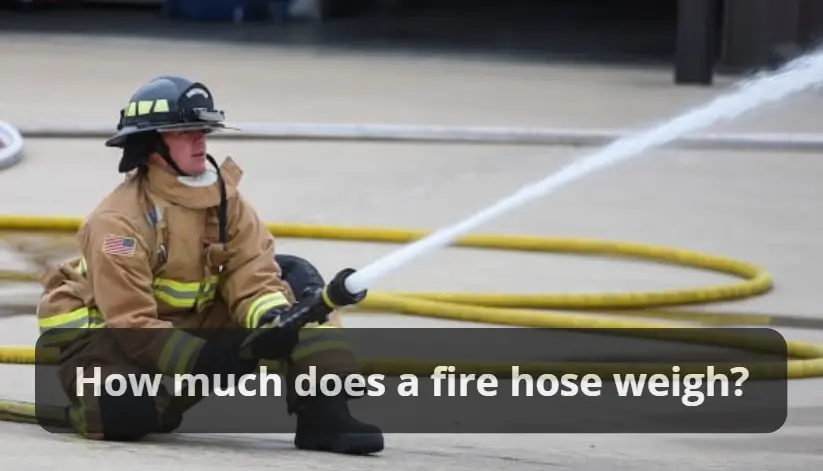How much does a fire hose weigh?
Table of Contents
Fire hoses are crucial tools in firefighting, designed to deliver water or other fire retardants to extinguish flames. They come in various types and sizes, each tailored for specific applications.

Types of Fire Hoses
Attack Hoses
Attack hoses are used to directly combat fires. They are typically smaller in diameter, making them easier to maneuver in tight spaces and during high-pressure operations.
Supply Hoses
Supply hoses, also known as relay hoses, are used to transport water from a hydrant or other water source to the fire scene. These hoses are larger in diameter to allow for greater water flow and are vital in maintaining a steady supply of water.
Forestry Hoses
Forestry hoses are used in wildland firefighting. They are lightweight and flexible, designed to be deployed quickly in rugged terrain where forest fires are common.
Materials Used in Fire Hoses
Natural Rubber
Some fire hoses are made from natural rubber, known for its flexibility and durability. This material provides excellent resistance to abrasion and maintains its integrity under high-pressure conditions.
Synthetic Materials
Modern fire hoses often use synthetic materials like polyurethane or nitrile rubber, which are lighter and more resistant to abrasion and chemicals. These materials enhance the hose’s durability and reduce its weight.
Factors Affecting the Weight of a Fire Hose
Several factors influence the weight of a fire hose, including its diameter, length, and the materials used in its construction.
Diameter of the Hose
The diameter of the hose significantly impacts its weight. Larger diameters allow for more water flow but also increase the hose’s weight. Common diameters range from 1 to 5 inches.
Length of the Hose
The longer the hose, the heavier it will be. Fire hoses can range from 50 feet to several hundred feet in length. Longer hoses are useful for reaching fires that are far from water sources.
Type of Material
The materials used in the hose’s construction also affect its weight. Synthetic materials tend to be lighter than natural rubber. Advanced materials can reduce the weight without compromising durability.
Average Weights of Different Fire Hoses
Attack Hose Weight
An attack hose typically weighs between 15 to 20 pounds for a 50-foot length when dry. When filled with water, the weight can increase significantly, reaching up to 80 pounds.
Supply Hose Weight
A supply hose can weigh around 50 to 60 pounds for a 50-foot length when dry. Like attack hoses, the weight increases considerably when filled with water, potentially exceeding 150 pounds.

Why the Weight of a Fire Hose Matters
Impact on Firefighters
The weight of a fire hose can significantly impact a firefighter’s ability to maneuver and control the hose during operations, affecting their overall efficiency and safety. Heavy hoses can lead to fatigue and reduced effectiveness in firefighting.
Transportation and Storage Considerations
Heavy hoses require more effort to transport and store, impacting the logistics of firefighting operations and the design of fire apparatus. Efficient storage solutions and proper handling techniques are essential.

How to Manage the Weight of Fire Hoses
Firefighters are trained in specific techniques to handle and maneuver heavy hoses, reducing the physical strain and risk of injury. Techniques include hose rolling, shoulder carries, and teamwork.
Equipment to Aid in Handling
Tools such as hose rollers, reels, and trolleys can help manage the weight and facilitate the deployment and retrieval of fire hoses. These tools are crucial in ensuring that hoses can be quickly and safely maneuvered.

Conclusion
Understanding the weight of fire hoses and the factors that influence it is crucial for efficient firefighting operations. Proper handling techniques and the use of appropriate equipment can help manage the weight, ensuring that firefighters can perform their duties safely and effectively.
FAQs
How much does a 100-foot fire hose weigh?
A 100-foot attack hose typically weighs between 30 to 40 pounds when dry, but the weight can double when filled with water.
Are there lightweight fire hoses available?
Yes, hoses made from synthetic materials like polyurethane are designed to be lighter while still providing durability and performance.
How do firefighters manage the weight of heavy hoses?
Firefighters use proper handling techniques and equipment such as hose reels and trolleys to manage heavy hoses.
Does the hose diameter affect its weight significantly?
Yes, larger diameter hoses are heavier, but they allow for greater water flow, which is essential for certain firefighting operations.
READ ALSO: 5 best garden hose nozzle

